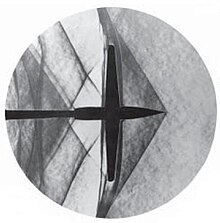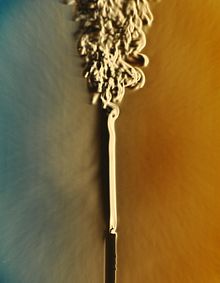Schlieren photography
The Schlieren photography is a photographic technique that in 1864 by the German chemist and physicist August Toepler was developed. It is used to map local fluctuations in the refractive index in liquids and gases.
This can be the simultaneous mixing or dissolution of different substances with one another, thermal convection movements or, for example, air shock waves around flying projectiles or profiles in the wind tunnel .
The Schlieren method is used accordingly in flow technology , ballistics , the investigation of the spreading and mixing of gases and solutions, and the investigation of heat exchange through convection .
The illustration opposite shows the functional principle of Schlieren photography. The volume region or layer to be examined (here: a burning candle with convection) (1) is illuminated from the left with parallel light (e.g. a point light source + collimator , both not shown) and through an objective (2) on the screen (4) shown. Most of the light (yellow arrows) hits a screen (3), often in the form of an edge. Density fluctuations of an inhomogeneous medium in the layer (1) guide some of the light rays (green arrow) past the screen (3); almost only this light creates the image on the screen. The brightness fluctuations of this image correspond to the local gradients of the refractive index, caused by the density fluctuations or mixing. For a high-contrast image of the flow, the light must be sharply focused on the edge of the diaphragm (3), which is achieved by using a point-like light source and arranging the diaphragm in the image plane of the light source.
Related procedures
A similar process is used for Eidophor video projection - but here the inhomogeneous layer is an oil film that is structured by an electron beam .
The Schlieren Particle Image Velocimetry (PIV Schlieren) determines the velocity of flow on the basis of the velocity of moving in their continued vortices or turbulences. The speed is determined based on two photos and the movement progress of a vortex. The optics are similar to that of Schlieren photography, the process is dependent on the presence of eddies or turbulence in the flow.
With the so-called Background Oriented Schlieren (BOS) it is not the Schlieren that are displayed, but a background with a grid. In the image, the position of the grid points is distorted according to the gradient of the refractive index. The process does not require a point light source and is related to the shadow process , in which there is no imaging at all, but the refractive index gradients lead to a collection or scattering of the light rays from a (quasi) parallel (point) source - each of which causes optically denser areas as a whole a converging lens increases the luminance on the screen and vice versa, areas with a lower refractive index create a dark spot ("shadow"). The shadow method is less sensitive than Schlieren optics because the light intensity differences are proportional to the second derivative of the refractive index, whereas with the Schlieren method they are proportional to its first derivative.
Web links
- Shock waves from supersonic aircraft , heise TP
- Schlieren effect. Video of the effect on YouTube
Individual evidence
- ↑ a b c Kai Risthaus: Investigations with a new type of flow measurement technology to visualize the feedback in open volumetric receivers , master's thesis at RWTH Aachen University 2015, page 10 ff.


